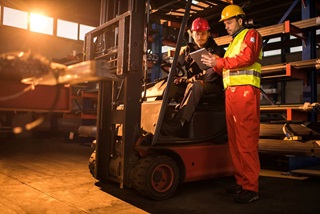Auditable Carbon Reduction Made Simple

Making the decision to switch to a more sustainable fuel source, such as our BioLPG forklift gas blend, can bring carbon savings of up to 32%, achieved by using a mix of 40% BioLPG and 60% conventional LPG, compared to using conventional LPG alone. As many companies, large and small, now have voluntary carbon reduction targets in place, being able to capture all savings accurately and consistently is important, so that all stakeholders can be certain that claims made about carbon savings from the use of this green gas are indeed true.
To help customers demonstrate the carbon savings they make when they use our blend of BioLPG and conventional LPG for their fleet of forklift trucks, we have been working in conjunction with the Green Gas Certification Scheme (GGCS) for several years. The GGCS provides an objective means of tracking transactions of green gas through the supply chain. Through the scheme, our customers can also access Renewable Gas Guarantees of Origin Certificates (RGGOs) for use when auditing their environmental impact.
Giving transparency to the manufacture and supply chain from start to finish, Calor begins the trackable process by providing an International Sustainability Carbon Certification (ISCC) to GGCS to verify that the feedstock - used as a base for its BioLPG forklift gas - is from a sustainable source. From this, the scheme then calculates the carbon savings made during the production of that batch of BioLPG.
The quantity of BioLPG forklift gas delivered into the country as part of that consignment is then logged by the GGCS, creating a bank of RGGO credits available for Calor to apply to each of our green customers who are on our BioLPG tariff. The system then calculates the amount of credits for the customer depending on the volume of gas they receive, and gives the customer access to the GGCS website, from which a recognised certificate detailing the carbon savings can be downloaded.
This smart system ensures certificates and carbon saving calculations are third-party qualified, fully auditable for customers and monitored by the GGCS. Moreover, it guarantees that the RGGOs given for the BioLPG forklift gas that customers receive, have not been double counted or double sold. The process is done automatically and has the added convenience that certificates can be downloaded as and when needed, rather than having to wait for quarterly, half year points. So, when you make the switch to Calor, you can prove the reduction in your carbon emissions from day one. The figures can be audited against environmental targets, so that our customers can show their own clients with confidence that it is taking action on building a more sustainable future.
To find out how we can help you reach sustainability targets with BioLPG forklift gas, visit www.calor.co.uk/flt. To find out more about Green Gas Certification Scheme visit www.greengas.org.uk